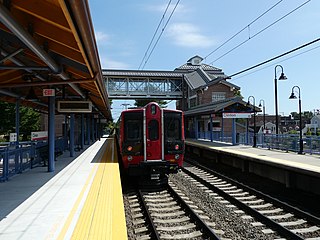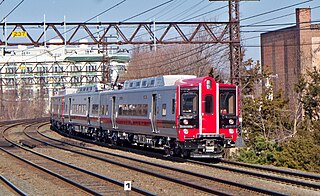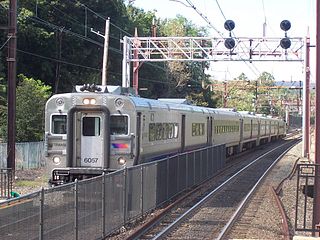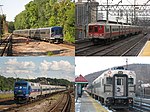Active rolling stock
Locomotives
| Builder and model | Photo | Build year | Year rebuilt | Fleet numbers | Power | Notes |
|---|---|---|---|---|---|---|
| EMD GP35R |  | 1964–1965 | 1991–1992; 2013–2017, 2019 | 101–108 (8 units) | 2,500 horsepower (1,900 kW) |
|
| EMD GP40FH-2M |  | 1966–1970 | 1992–1993; 2007 | 4900–4905 (6 units) | 3,000 horsepower (2,200 kW) |
|
| EMD GP40PH-2M |  | 1968 | 1992; 2007 | 4906 (1 unit) | ||
| EMD F40PH-3C |  | 1976–1981 | 2009–2010 | 4907–4914 (8 units) | ||
| GE P32AC-DM |  | 1995–2001 | 2012–2015 | 201–231 (31 units) | 3,200 horsepower (2,400 kW) |
|
| Brookville BL20GH |  | 2008 | 2017– | 110–115, 125–130 (12 units) | 2,250 horsepower (1,680 kW) |
|
| Brookville BL14CG |  | 2009 | – | 401–402 (2 units) | 2,000 horsepower (1,500 kW) |
|
| EMD GP40-3H |  | 1971 | 2016-2018 | 6698-6699 (2 units) | 3,000 horsepower (2,200 kW) |
|
Future locomotives
| Builder and model | Build year | Fleet numbers | Power | Notes |
|---|---|---|---|---|
| Siemens SC-42DM Charger | 2023–2027 | (33 units) | 4,400 horsepower (3,300 kW) |
|
In December 2020, the Metro-North board approved a Federal Transit Administration funded $334.9 million contract for Siemens to manufacture and test 19 dual-mode locomotives with an option for an additional eight more. 19 of the 27 dual-mode Locomotives ordered have already been fully approved for $231.6 million with the other eight at a cost of $82.1 million. In addition, the contract also includes capital spare parts for $12.9 million, a training simulator for $1.5 million, test equipment for $3 million, and extended warranty for $3.6 million. This contract includes 144 in total option locomotives with 66 additional locomotives for Long Island Rail Road in an alternate configuration, 32 additional locomotives for Metro-North, 20 for the Connecticut Department of Transportation, and 26 locomotives in an alternate configuration for Amtrak/NYSDOT. These dual modes would be able to work on both Amtrak and Metro-North signal systems and will be able to sustain 110 miles per hour (180 km/h) in service. [4] [5]
Push-pull coaches
These cars are non-powered.
| Builder and model | Photo | Build year | Year Rebuilt | Fleet Numbers | Number Active | Notes |
|---|---|---|---|---|---|---|
| Bombardier Comet II |  | 1983, 1987 | 2009 | 6125, 6127, 6129, 6131, 6134, 6136, 6138, 6140, 6142–6149, 6176, 6178, 6180 | 19 | Formerly used for West of Hudson service, transferred in 2009. Not rebuilt until transferred to East of Hudson. |
| Bombardier Shoreliner I |  | 1983 | 1995–1996; 2008–2009 | 6101, 6103, 6105, 6107, 6109, 6150–6160, 6162, 6164, 6166, 6201, 6203, 6205, 6207, 6209, 6250–6260, 6262, 6264, 6266, 6268 | 39 | |
| Bombardier Shoreliner II |  | 1987–1988 | 2008–2009 | 6111, 6113, 6115, 6117, 6119, 6121, 6123, 6161, 6163, 6165, 6167–6175, 6177, 6179, 6182, 6184, 6186, 6190, 6211, 6213, 6215, 6217, 6219, 6223, 6225, 6227, 6229, 6230, 6232, 6234, 6236, 6238, 6240, 6270, 6272, 6274, 6276, 6278 | 45 | 6188 wrecked and retired after 2013 accident at Spuyten Duyvil |
| Bombardier Shoreliner III |  | 1991–2002 | NA | 6301-6310 6330-6344, 6346-6362 6364, 6366, 6368, 6370, 6372, 6374 | 48 | 6345 wrecked and retired after 2013 accident at Spuyten Duyvil. |
| Bombardier Shoreliner IV |  | 1996–2002 | 6221, 6222, 6311–6320 | 57 | 6222, 6288, and 6440 wrecked and retired after 2013 accident at Spuyten Duyvil. | |
| Alstom Comet V |  | 2004 | 6700–6714, 6750–6799 | 65 | Operated by NJ Transit for West of Hudson service. | |
| Budd club/lounge | 1949 | 1-3 | 3 | Only used on special trains, ex-Lackawanna and New York Central. [6] |
Future push-pull coaches
In August 2023, CTDOT approved a contract with Alstom for 60 single-level passenger cars. The cars will replace the existing Shoreliner coach fleet on the Waterbury Branch and the Danbury Branch, as well as Mafersa coaches and leased MBTA MBB coaches on the Hartford Line. Deliveries are expected to begin in 2026. [7] [8]
Electric multiple units
M3A and M7A cars draw power from 650 V DC third rail with under-running contact shoes. M8 draw power from third rail, both over- and under-running, or 12.5 kV 60 Hz and 25 kV 60 Hz AC catenary.
| Builder and model | Photo | Build year | Year rebuilt | Fleet numbers | Number Active | Notes |
|---|---|---|---|---|---|---|
| Budd M3A |  | 1983–1985 | 2008–2015 | 8000–8141 | 140 | |
| Bombardier M7A |  | 2004–2006 | N/A | 4000–4335 | 334 | 4333 burned and destroyed in 2013 accident in Valhalla. |
| Kawasaki M8 |  | 2009–2015 | 9100–9421, 9460, 9462, 9464, 9466, 9468, 9470, 9472, 9474, 9476 (unpowered single cars) 9500–9519 9560, 9562, 9564, 9566, 9568, 9570, 9572, 9574, 9576, 9578, 9580, 9582, 9584, 9586, 9588, 9590 (unpowered single cars) 9600–9623 | 471 |
|
Possible future electric multiple units
| Builder and model | Photo | Build year | Year rebuilt | Fleet numbers | Notes |
|---|---|---|---|---|---|
| Kawasaki M9A |  | TBD | N/A | TBD Up to 300 cars |
MTA originally planned to order 188 M9A cars for Metro-North as part of the 2015-2019 Capital Program. [9] In June 2018, Metro-North announced that they would elect to not exercise their options for the M9 order, instead overhauling their M3A units to extend their lifespan. [10] However, that November, Metro-North stated that they "are working with LIRR to procure 170 new M9A cars in the next Capital Program to provide additional capacity and replace M3As." [11]
































